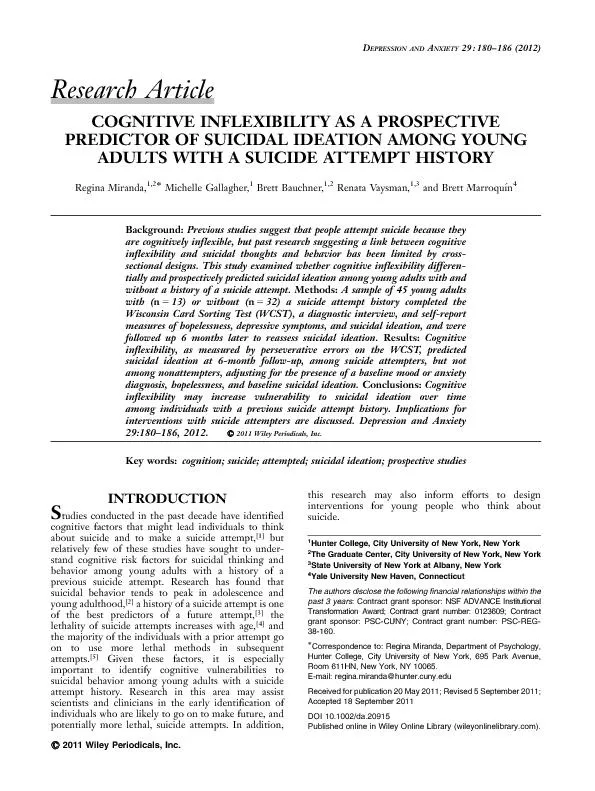

r 2011WileyPeriodicalsIncKeywordscognitionsuicideattemptedsuicidalideationprospectivestudiestudiesconductedinthepastdecadehaveidentifiedcognitivefactorsthatmightleadindividualstothinkaboutsuici ID: 296654
Download Pdf The PPT/PDF document "ResearchArticleCOGNITIVEINFLEXIBILITYASA..." is the property of its rightful owner. Permission is granted to download and print the materials on this web site for personal, non-commercial use only, and to display it on your personal computer provided you do not modify the materials and that you retain all copyright notices contained in the materials. By downloading content from our website, you accept the terms of this agreement.
ResearchArticleCOGNITIVEINFLEXIBILITYASAPROSPECTIVEPREDICTOROFSUICIDALIDEATIONAMONGYOUNGADULTSWITHASUICIDEATTEMPTHISTORYReginaMiranda,MichelleGallagher,BrettBauchner,RenataVaysman,andBrettMarroquBackground: r 2011WileyPeriodicals,Inc.Keywords:cognition;suicide;attempted;suicidalideation;prospectivestudiestudiesconductedinthepastdecadehaveidentifiedcognitivefactorsthatmightleadindividualstothinkaboutsuicideandtomakeasuicideattempt,empt,butrelativelyfewofthesestudieshavesoughttounder-standcognitiveriskfactorsforsuicidalthinkingandbehavioramongyoungadultswithahistoryofa 1 r 2011WileyPeriodicals,Inc.EPRESSIONAND29:180 186(2012)29:180 186,2012. Previousresearchsuggeststhatonereasonpeopleconsiderattemptingsuicideisthattheyarecognitivelyinflexibleandthusunabletothinkofotheralternativeswhenconfrontedwithlifestressors.stressors.Cognitiveinflexibility,definedasthefailuretomodifydecision-makingbehaviorinresponsetoexternalfeedbackandchangingenvironmentalcircumstances,hasbeentheorizedtocontributetosuicidalideationandbehaviorbyresultingincognitiveconstrictionandproblem-solvingdeficits.deficits.Thisdiathesis-stressmodelsuggeststhatcognitivelyinflexibleindividualsareunabletogenerateeffectivesolutionswhendealingwithstressfulsituations,andthattheresultantfeelingofhopelessnessincreasesriskforsuicidalbehavior.Inadditiontodistinguishingdepressedanddyspho-ricsamplesfromcontrols,trols,cognitiveflexibilityhasalsobeenshowntodistinguishthosewithandwithoutahistoryofsuicidality.Keilpandcolleaguesfoundthatdepressedpatientswhohadpreviouslymadeahigh-lethalitysuicideattemptshowedmorecognitiveinflexibility,inthattheyscoredlowerontestsofexecutivefunctioning,comparedtodepressedpatientswithahistoryofalow-lethalitysuicideattempt,andalsocomparedtodepressedpatientswithoutasuicideattempthistory..Depressedadultpatientswithsuicidalideationhavealsoexhibitedpoorerperfor-manceontestsofexecutivefunctioningthatinvolvedcognitiveflexibilitythandepressedpatientswithoutsuicidalideation.tion.Finally,astudywithelderlydepressedpatientsfoundthatthosewithapasthistoryofsuicidalideationorattemptexhibitedworseperformanceonabatteryofexecutivefunctioningteststhanthosewithoutahistoryofsuicidalideationorattempts.pts.Itisunclear,however,whethercognitiveinflexibilityismerelyatraitthatdistinguishessuicideattemptersfromnonattemptersorwhetheritalsoincreasesriskoffuturesuicidalideationorattempts.Previousstudiesarelimitedbytheircross-sectionaldesigns.ResearchbyPerrahandWichmansuggeststhatsuicideattempterswhoareassessedlongafteranattemptarelesscognitivelyinflexiblethansuicideattemptersassessedjustafteranattempt.pt.Prospec-tiveresearchmayshedlightonwhethercognitiveinflexibilitydistinguishesnonattemptersfromsuicideattempterswhoarenotcurrentlyinthemidstofasuicidalepisode,andwhethersuchinflexibilitymightpredictriskforfuturesuicidalthinkingandbehavior.THEPRESENTSTUDYThepresentstudyexaminedwhethercognitiveinflexibilitywouldprospectivelypredictsuicidalideation,andwhetheritwoulddosomoreamongsuicideattemptersthanamongyoungadultswithoutasuicideattempthistory.Wepredictedthatcognitiveinflexibilitywouldbeassociatedwithincreasedsuicidalideationovertime,andthattherelationshipbetweeninflexibilityandideationwouldbestrongeramongsuicideattemptersthanamongnonsuicideattempters.PARTICIPANTSForty-fiveyoungadultvolunteers,aged18 22,(0.73)tookpartinthisstudyformonetarycompensation.Participantswereselectedfromasampleof1,011adultswhowerescreenedforahistoryofasuicideattemptaspartofastudyofsocial-cognitivepredictorsofsuicidalbehavior..Fromthislargersample,96youngadultswererecruitedtocompletebaselinemeasuresbasedonwhethertheyreportedahistoryofapastsuicideattempt(37),ornosuicideattempthistory(59)(Notethattherateofasuicideattemptinthelargersamplewas8%.).Ofthenonattempters,participantswerealsorecruitedbasedonwhethertheyreportedanysuicidalideationintheprevious2weeks.Forty-fiveofthe96individualsreturned6monthslater(Thosewhodidnotreturneitherdidnotrespondtoourrequesttoparticipateinthefollow-upstudyordeclinedtoparticipate.).Ofthese45participants,13wereclassifiedashavingasuicideattempthistoryatbaseline(seecriteriabelow),and32wereclassifiedashavingnosuicideattempthistory(10ofwhomhadreportedsuicidalideationatbaseline).Therewerenostatisticallysignificantdifferencesinsexandethnicitybetweenparticipantswhodidordidnotparticipateinthefollow-up.However,participantswhotookpartinthefollow-upweresignificantlyyounger(0.73)thanparticipantswhodidnottakepartinthefollow-up(.01.Therewerenosignificantdifferencesbetweenindividualswhodidanddidnottakepartinthefollow-upinratesofasuicideattempt,norontheotherstudymeasures.Thus,thepresentanalysesfocusonthe45participantswhotookpartinthe6-monthSUICIDEATTEMPTHISTORY.ASuicidalBehaviorScreening(SBS)wasusedtoscreenforlifetimehistoryofsuicideattemptsatbaseline.Thisself-reportmeasureincludesquestionsderivedfromtheDiagnosticInterviewScheduleforChildren.Children.Suicideattempthistorywasdeterminedbythequestion,Haveyouever,inyourwholelife,triedtokillyourselformadeasuicideattempt?AgreementbetweenresponsestothisquestionandresponsestotheBSSquestionaboutsuicideattempthistory(seebelow)washigh,.78.Inaddition,participantscompletedtheSelf-HarmBehaviorQuestionnaire(SHBQ),ameasuredesignedforusewithnonclinicalsamplesofyoungadults.adults.TheSHBQdistinguishesbetweennonsuicidalself-injuryandsuicideattempts,inthatindividualsareaskedaboutinstancesinwhichtheypurposelytriedtohurtthemselves(Haveyoueverhurtyourselfonpurpose?)andalsoinstancesinwhichtheytriedtokillthemselves(Haveyoueverattemptedsuicide?).Participantswhoendorseasuicideattempthistoryarealsoaskedfurtherdetailsabouttheirattempt,includingthenumberofpreviousattempts,methodoftheirmostrecentattempt,andwishtodieduringtheattempt.ParticipantswereinitiallyscreenedforasuicideattempthistorybasedontheirresponsetotheSBSbutwereclassifiedassuicideattemptersiftheyendorsedanattemptontheSHBQthatincludedawishtodie.AgreementbetweenresponsestoquestionsaboutsuicideattempthistoryontheSBSandSHBQwashigh,.84.Thirteenparticipantswereclassifiedashavingasuicideattempthistory,withnineoftheseindividualsreportingahistoryofoneprevioussuicideattemptontheSHBQandfourindividualsreportingthattheyhadmadetwo2Mirandaetal.DepressionandAnxiety DepressionandAnxietyResearchArticle:CognitiveInflexibilityandSuicidalBehavior previousattempts.Methodofthemostrecentattemptincludedingestion(4),cutting(5),oranothermethod(e.g.suffocation,hanging,andjumping)(COGNITIVEINFLEXIBILITY.ParticipantscompletedthecomputerizedversionoftheWisconsinCardSortingTestestdesignedtoassessabstractreasoningandtheabilitytoshiftcognitivestrategiesinresponsetochangingrules.Duringthetask,participantsarepresentedwithfourcardsatthetopofthescreenthatvarybynumber,shape,andcolor.Atargetcardisthenpresented,andtheparticipantmustmatchthetargetcardtooneofthefourcardsshownbasedononeofthethreestimuluscharacteristics(number,shape,andcolor).Thecomputerinformstheparticipantwhethertheattemptatsortingwascorrectorincorrect,andtheparticipantmustusethisfeedbacktoinferthematchingrule.Afterapredeterminednumberofsuccessfulmatches,thematchingruleisaltered,andtheparticipantmustagaininferthenewsortingrule.Cognitiveinflexibilitywasmeasuredusingnumberperseverativeerrors,orthenumberoftrialsonwhichaparticipantpersistsinsortingthecardusingastimuluscharacteristicthatisnolongercorrect.TheWCSThasbeenusedpreviouslyasameasureofcognitiveinflexibilityandhasbeenfoundtodistinguishdysphoricfromnondysphoricindividuals,individuals,andalsoindividualshighinruminationfromthoselowinrumination.rumination.ANXIETYANDMOODDISORDERDIAGNOSESANDDEPRESSIVESYMPTOMS.Thecomputer-assistedyoungadultversionoftheDiagnosticInterviewScheduleforChildren(C-DISC-IV;Shafferetal.)al.)wasadministeredtoparticipantsbylayinterviewers.TheC-DISC-IVisastructureddiagnosticinterviewthatusescomputeralgorithmscoringtoyielddiagnosesbasedontheDiagnosticandStatisticalManualofMentalDisorders,FourthEditionEditionTheC-DISC-IVhasdemon-stratedreliabilityandvaliditycomparablewiththatofotherdiagnosticmeasures.s.Forthepurposesofthecurrentstudy,thefollowingdiagnoseswereassessed:generalizedanxietydisorder,socialanxietydisorder,majordepressivedisorder,dysthymicdisorder,mania,andhypomania.Inthepresentsampleof45participants,11individuals(24%)hadatleastoneoftheabovediagnosesatbaseline,withtwoparticipants(4%)meetingcriteriafortwodiagnoses.Inaddition,depressivesymptomswereassessedusingtheBeckDepressionInventory-II(BDI-II),a21-itemself-reportquestion-nairethatinquiresaboutsadness,anhedonia,andothersymptomsofdepressionona0-to3-pointLikertscale.scale.Totalscorescanrangefrom0to63,andinthepresentsample,scoresrangedfrom0to38,withameanscoreof14.2(8.9).Cronbachswas.90inthepresentsample.TheBeckHopelessnessScale(BHS)isa20-itemself-reportquestionnairethatassessesnegativeexpectationsaboutthefuture.future.Questionsarepresentedinatrue/falseformat,andscorescanrangefrom0to20.Scoresrangedfrom0to20inthepresentsample,withameanscoreof6.2(4.7).Cronbachswas.87inthepresentsample.SUICIDALIDEATION.TheBeckScaleforSuicidalIdeation(BSS)isa21-itemself-reportmeasurethatassessespassiveandactivesuicidalideationduringthepreviousweek,andincludesquestionsaboutwishtodie,frequencyofideation,suicideplans,andaccesstomeans.means.Totalscoresaretabulatedbysummingitems1 19.Anadditionalquestioninquiresaboutwhetherindividualshaveeverpreviouslymadeasuicideattempt.Scorescanrangefrom0to38.Inthepresentsample,scoresatbaselinerangedfrom0to14,withameanscoreof1.5(3.3),andscoresatfollow-uprangedfrom0to8,withameanof1.0(2.0).Forthecurrentsampleof45participants,Cronbachswas.95atbaselineand.97at6-monthDuringaninitialscreeningsession,1,011participantscompletedself-reportmeasuresthatincludedtheSBSandotherscalesnotrelevanttothepresentanalyses.Asubsampleof96individualswasthenrecruitedtoparticipateinabaselinesessionthatoccurredapproximately3weekslater.Duringthisbaselinesession,participantscompletedtheBSS,BDI,BHS,andSHBQ,alongwithcomputerizedtasksthatincludedtheWCSTandC-DISC-IV,aswellasothertasksnotrelevanttothepresentstudy.Approximately6monthsafterthebaselinesession,the96participantswerecontactedbyelectronicmailandphoneandinvitedtoparticipateinthepresentfollow-upstudy.Atotalof45individualsweresuccessfullyrecruited,andcompletedself-reportquestionnairesthatagainincludedtheBSS,aswellasothermeasuresnotincludedinthepresentanalyses.Aftereachofthethreestudysessions,researchassistantscompletedariskassessmentprocedurebeforedebriefingparticipants.Individualswhoreportedsuicidalideationwithaplanwereinterviewedbyalicensedclinicalpsychologistandreferredforfurtherassessment,ifnecessary..Allparticipantswereprovidedwithalistoflocaltreatmentreferrals.RESULTSDEMOGRAPHICCHARACTERISTICSDemographicinformationforthesampleissummar-izedinTable1.Therewasnostatisticallysignificantdifferenceintheproportionofmalesvs.femaleswhoreportedasuicideattempthistoryatbaseline.How-ever,therewasanomnibusdifferencebyrace/ethnicity, TABLE1.DemographiccharacteristicsAttempters(13)Nonattempters(32)All()18.31(0.63)18.31(0.78)18.31(0.73)(%)Female12(92%)23(72%)35(78%)Male1(8%)9(28%)10(22%)(%)White3(23%)8(25%)11(24%)Black1(8%)2(6%)3(7%)0(0%)10(31%)10(22%)Asian7(54%)11(34%)18(40%)Other2(15%)1(3%)3(7%)ResearchArticle:CognitiveInflexibilityandSuicidalBehaviorDepressionandAnxiety DepressionandAnxietyMirandaetal. 9.52(likelihoodratio),.05,withfewerHispanicparticipants(0%)reportingasuicideattemptthanexpectedbychance,GROUPDIFFERENCESATBASELINEANDCORRELATIONSAMONGVARIABLESSuicideattemptershadhighersuicidalideationatbaseline,2.83,.05,comparedtononat-tempters.Theyalsomoreoftenmetcriteriaforamoodoranxietydiagnosis,6.46(continuitycorrec-.05,comparedtononattempters(Table2).However,therewasnostatisticallysignificantdiffer-encebetweenthetwogroupsoncognitiveinflexibility,asmeasuredbythetotalnumberofperseverativeerrorsontheWCST,(43).19,noronhope-lessness,.14,ordepressivesymptoms,(43).95.Means,s,andeffectsizesforeachgrouparelistedinTable2.CorrelationsamongvariablesaresummarizedinTable3.Perseverativeerrorswerenotsignificantlyrelatedtoanybaselinestudyvariablesbutwereassociatedwithsuicidalideationatfollow-up.Baselinehopelessness,suicideattempthistory,anddiagnosisweresignificantlyandpositivelyassociatedwithsuici-dalideationatbaseline,anddepressivesymptoms,hopelessness,andsuicideattempthistorybutnotdiagnosisweresignificantlyandpositivelyassociatedwithsuicidalideationatfollow-up.GROUPDIFFERENCESOVERTIMEBaselinecognitiveinflexibilitywasexaminedasapredictorofsuicidalideationatfollow-upviaahierarchicallinearregression.Twomodelswerebuilt,withcontinuouspredictorvariablescenteredaroundtheirmeans.Cognitiveinflexibilitywasenteredasapredictorofsuicidalideationinthefirststepoftheregression,adjustingforbaselinesuicidalideation,thepresenceofamoodoranxietydiagnosis,asuicideattempthistory,andhopelessness(Model1).Theinteractionbetweencognitiveinflexibility(centered)andsuicideattempthistorywasenteredintothesecondstepoftheregression(Model2)(NotethatBDIscorewasnotincludedinthemodels,inordertoreducethenumberofpredictorsinthefinalanalyses,giventhesmallsamplesize,andgiventhatwhenenteredintotheregression,itdidnotpredictideationatfollowup,0.00.).Standarderrorsand95%confidenceinter-valsforunstandardizedregressioncoefficientswerecomputedviabootstrappingusing1,000resamples.es.Model1accountedforasignificantproportionofvariabilityinsuicidalideationat6-monthfollow-up,Adjusted.01,withhopelessnesspredictingincreasedsuicidalideationandthepresenceofadiagnosispredictingdecreasedsuicidalideationat6-monthfollow-up(althoughthelatterwasfoundat.10level)(Table4).TheadditionoftheinteractionbetweencognitiveinflexibilityandsuicideattempthistoryinModel2explainedanadditional TABLE2.ScoresonsymptommeasuresatbaselineAttempters(13)Nonattempters(32)All(45)CohensPerseverativeerrors)7.69(6.80)10.63(6.65)9.78(6.75)0.44BHSScore7.85(4.90)5.56(4.50)6.22(4.68)0.49BDIScore14.31(9.12)14.13(9.00)14.188.930.02BSSScore4.31(4.97)0.38(0.91)1.51(3.25)1.10Anymood/anxietyDx(%)7(54%)4(13%)11(24%)Socialphobia3(23%)3(9%)6(13%)Generalizedanxietydisorder2(15%)0(0%)2(4%)Majordepressivedisorder2(15%)1(3%)3(7%)Dysthymicdisorder0(0%)0(0%)0(0%)Mania2(15%)0(0%)2(4%) TABLE3.CorrelationsamongstudyvariablesBSS-1BDIDiagnosisAttemptBHSWCSTBSS-2BaselineSI(BSS-1) DepressiveSxs(BDI).04 Mood/anxietydiagnosis.37.17 Suicideattempt.55.01.40Hopelessness(BHS).41.22 PerseverativeErrors(WCST).19.21.04 Follow-upSI(BSS-2).27.21.334Mirandaetal.DepressionandAnxiety DepressionandAnxietyResearchArticle:CognitiveInflexibilityandSuicidalBehavior 11%ofvariabilityinsuicidalideation.Thatis,therewasastatisticallysignificantinteractionbetweencognitiveinflexibilityandsuicideattempthistory.SimpleeffectsfortheinteractionbetweencognitiveinflexibilityandsuicideattempthistorywereprobedusingthemethodsuggestedbyHayesandMatthes.s.Cognitiveinflexibilitypredictedsuicidalideationamongindividualswithasuicideattempthistory,.01,butnotamongindividualswithoutasuicideattempthistory,.17.Theinterac-tionisshowninFigure1.Inpreviouscross-sectionalresearch,cognitivein-flexibilityhasbeenfoundtodistinguishindividualswithcurrentsuicidalideationorarecentattemptfromnonsuicidalcontrolgroups.ps.Thesefindingssug-gestthatcognitiveinflexibilitymayincreaseriskforsuicidalthoughtsandbehavior.Thepresentstudyextendedthislineofresearchbyexaminingcognitiveinflexibilityasaprospectivepredictorofsuicidalideation.Wefoundthatcognitiveinflexibilitypredictedsuicidalthinkingata6-monthfollow-up,althoughonlyamongyoungadultswithapriorlifetimesuicideattempt.Ourresultssuggestthatevenamongyoungadultswhoareassessedlongafterapriorsuicidalcrisis,cognitiveinflexibilityincreasesvulner-abilityforsuicidalideationovertime.Thisstudysfindingscanbeinterpretedinlightofprevailingcognitivetheoriesofvulnerabilitytosuicidalideationandbehavior.Fluidvulnerabilitytheory,,whichdrawsuponBeckstheoryofmodes,modes,proposesthatwhenindividualsengageinsuicidalbehavior,theconnectionsbetweensuicide-relatedthoughts,feelings,andbehaviorsarestrengthenedinmemory,thusloweringthethresholdfortriggeringfuturesuicidalthoughtsandattempts.Itispossiblethatcognitiveinflexibilityplaysaroleinthisprocess.Individualswithahistoryofasuicideattemptmaybemorevulnerabletofuturesuicidalideationbecausetheyarefixatedonsuicide-relatedsolutionsthattheyhaveconsideredorutilizedinthepast,andarethusunabletogeneratealternativestrategiestocurrentproblems.WenzelandBecksuggestthatthistypeofcognitiveconstriction,whichtheydescribeasapreoccupationwithsuicideasasolution,maytransactwithhopelessnesstoincreaseriskforfuturesuicidalthoughtsandbehavior..Onewayinwhichcognitiveinflexibilitymaycon-tributetosuicidalideationisbyincreasingmaladaptiverehearsal.Previousresearchsuggeststhatcognitiveinflexibilityisassociatedwithrumination,n,aformofperseverativethinkingthathasbeenfoundtopredictincreasedsuicidalideationovertime..Alterna-tively,cognitiveinflexibilitymayincreaseriskforsuicidalthoughtsandbehaviorthroughdeficitsinproblemsolving.SchotteandClumsuggestthatcognitiveinflexibilityresultsinproblem-solvingdiffi-culties,andthatwhenindividualsareunabletoeffectivelymanagelifestressors,theyexperiencefeelingsofhopelessness,whichincreasestheirriskforsuicidalideation.ideation.Previousstudieshavefoundthatsuicideattemptersgeneratefewersolutionstopro-blemscomparedtononattempters,andthatthesolutionsarelesseffective..Moreresearchisneeded Figure1.Interactionbetweennumberofperseverativeerrorsandsuicideattempthistoryinpredictingsuicidalideationat6-monthfollow-up. TABLE4.Predictorsofsuicidalideationat6-monthfollow-upbs.e.1BaselineSI0.000.150.03(0.20,0.40).00.49Mood/anxietyDx1.290.650.04(0.230.060.01(0.08,0.33).59Suicideattempt1.761.000.10(0.34,3.56).43Perseverativeerrors0.110.060.01(0.02,0.20).472BaselineSI0.040.180.04(0.14,0.65).08.60Mood/anxietyDx1.160.620.08(2.30,0.10)0.240.070.02(0.07,0.34).65Suicideattempt1.812.460.89(7.27,3.68).49Perseverativeerrors0.050.040.00(0.03,0.13).22Persev.0.220.540.21(1.90,0.49).48Estimatedusingabootstrapmethodwith1,000resamplesinModel1and999resamplesinModel2.ResearchArticle:CognitiveInflexibilityandSuicidalBehaviorDepressionandAnxiety DepressionandAnxietyMirandaetal. toexaminethepossiblerelationshipsbetweencognitiveinflexibility,problem-solving,hopelessness,andsuici-dalideation.Incontrasttothepreviousresearch,thecurrentstudydidnotfinddifferencesincognitiveinflexibilitybetweenthosewithandwithoutahistoryofapriorsuicideattempt.Oneexplanationmightbethat,unlikethecurrentstudy,thepreviousstudiesassessedcognitiveinflexibilityamongsuicideattempterswhowerehospitalizedsoonafteranattempt,pt,oramongindividualswhowereexperiencingcurrentsuicidalideationinthecontextofdepression..Suicideattempterswhoareassessedwellpasttheirattemptsmaybemorecognitivelyflexiblethanattemptersassessedwhileinthemidstofasuicidalcrisis.crisis.Alternatively,thepreviousresearchhasfoundthatformerlydepressedindividualswithahistoryofsuicidalideationorattemptsdifferedfromdepressedandnondepressedindividualswithoutahistoryofidea-tion/attemptsonproblemsolvingonlyafteranegativemoodinduction.ction.Itisthuspossiblethattheabsenceofdifferenceswasowingtothelackofdifferencesinmood.Thisisapossibility,giventhatBDIscoresdidnotdifferbetweenthetwogroups.Nevertheless,itshouldbenotedthat,inthisstudy,cognitiveinflex-ibilitywasfoundtopredictideationat6-monthfollow-upevenafteradjustingforthepresenceofamoodoranxietydiagnosis.Oneunexpectedfindinginthisstudywasthatthepresenceofamoodoranxietydiagnosisatbaselinewasassociatedwithdecreasedsuicidalideationat6-monthfollow-up(atatrendlevel).Giventhattherewasnostatisticallysignificantbivariaterelationshipbetweendiagnosisandsuicidalideationatfollow-up,itispossiblethatthenegativerelationshipbetweendiag-nosisandideationafteradjustingforothervariablesisowingtostatisticalsuppression(i.e.asdiagnosiswaspositivelyrelatedtoothervariablesincludedintheanalyses),suchthattherelationshipbetweendiagnosisandsuicidalideationwasclarifiedonceallpredictorswereenteredintotheanalysis.ysis.Giventhatthiswasatrend-levelfindinginasmallsample,thisrelationshipshouldbeexaminedinalargersample.Itisalsopossiblethatothervariablesnotincludedinthisstudy,suchaswhetherparticipantssoughttreatment,mightaccountforthesefindings.Forinstance,participantswithadiagnosismayhavebeenmorelikelytoreceivetreatmentandthustoexperiencedecreasesinideationowingtotreatment.Thisexplanationisspeculativebutmaywarrantexaminationinfutureresearch.Limitationsofthepresentresearchincludethesizeofthesample,asonly47%ofindividualsfromthebaselinesampleof96participantstookpartinthe6-monthfollow-up.Alargersamplethanthepresentonewouldbeneededtodetecttheapproximatelymediumeffectsize(.44)forthedifferencebetweengroupsinperseverativeerrorsthatwasfoundinthisstudy.Furthermore,thefactthatthesamplewasnotfromaclinicalsettinglimitsthegeneralizabilityofthesefindingstoyoungadultsfromanonclinicalsetting.Atthesametime,ahistoryofasuicideattemptisoneofthebestpredictorsofafuturesuicideattempt,empt,youngadulthoodisatimeofincreasedriskforsuicidalbehavior,,andadolescentsandyoungadultstendnottodisclosetheirsuicidalthoughtsandbehavior..Thus,examiningcognitivefactorsthatincreasevulner-abilitytosuicidalideationamongyoungadultswithahistoryofasuicideattemptmayprovideinformationaboutwhethertheseindividualswillconsidersuicideinthenearfuture.Anotherlimitationofthisstudyisthatsuicideattempthistorywasnotconfirmedbyclinicianinterview.Althoughself-reportcanbeausefultoolinpsychologicalresearch,adolescentsoftenreportsensitivebehaviorsinaccurately..Consequently,amultimethodapproach,whichwouldincludebothself-reportandclinicianassessment,iscrucialtofullyunderstandingacomplexphenomenonsuchassuicide.Researchconductedinthepastdecadehasidentifiedanumberofcognitivefactorsthatmayincreaseriskforsuicidalthoughtsandbehavior,includingrumination,overgeneralautobiographicalmemory,andimpulsiv-ity..Cognitiveinflexibilitymayrepresentamoregeneralcognitivevulnerabilitythatisimplicatedineachoftheseriskfactors.Inthepresentstudy,wefoundthatlowercognitiveflexibilitypredictedsuicidalideationat6-monthfollow-upamongpriorsuicideattempters.Althoughthecurrentstudyprovidesprospectiveevidencethatcognitiveinflexibilitymayincreaseriskforsuicidalthinkingovertime,moreresearchisneededtoexaminethisrelationshipoveralongerfollow-upperiodandtoidentifypossiblemediators,suchasrumination,problem-solvingdefi-cits,orhopelessness.Inlightofthecurrentfindings,cliniciansmaywishtogaugethelevelsofcognitiveinflexibilityinindividualswithasuicideattempthistorytoassesstheirriskforfuturesuicidalideation.Inaddition,thepresentfindingspointtoaneedfordevelopinginterventionsthatincreasecognitiveflex-ibility.Suchinterventionsmaybeparticularlyhelpfulindecreasingcontinuedsuicidalideationamongindividualswhohavemadeapriorsuicideattempt.1.EllisTE.CognitionandSuicide:Theory,Research,andTherapy.Washington,DC:AmericanPsychologicalAssociation;2.CentersforDiseaseControlandPrevention.WISQARSLeadingCausesofDeathReports,2007.Availablefrom:http://webappa.cdc.gov/sasweb/ncipc/leadcaus10.html.RetrievedMay9,2011.3.LewinsohnPM,RohdeP,SeeleyJR.Psychosocialriskfactorsforfutureadolescentsuicideattempts.JConsultClinPsychol1994;62:297 305.6Mirandaetal.DepressionandAnxiety DepressionandAnxietyResearchArticle:CognitiveInflexibilityandSuicidalBehavior 4.SpicerRS,MillerTR.Suicideactsin8states:incidenceandcasefatalityratesbydemographicsandmethod.AmJPublicHealth2000;90:1885 1891.5.BeautraisAL.Subsequentmortalityinmedicallyserioussuicideattempts:a5yearfollow-up.AustNZJPsychiatry2003;37:595 599.6.PatsiokasAT,ClumGA,LuscombRL.Cognitivecharacteristicsofsuicideattempters.JConsultClinPsychol1979;47:7.SchotteDE,ClumGA.Problem-solvingskillsinsuicidalpsychiatricpatients.JConsultClinPsychol1987;55:49 54.8.SchotteDE,ClumGA.Suicideideationinacollegepopulation:atestofamodel.JConsultClinPsychol1982;50:9.ChannonS.Executivedysfunctionindepression:theWisconsinCardSortingTest.JAffectDisord1996;39:107 114.10.MartinDJ,OrenZ,BooneK.Majordepressivesanddysthy-micsperformanceontheWisconsinCardSortingTest.JClinPsychol1991;47:684 690.11.KeilpJG,SackeimHA,BrodskyBS,OquendoMA,MaloneKM,MannJJ.Neurologicaldysfunctionindepressedsuicideattemp-ters.AmJPsychiatry2001;158:735 741.12.MarzukPM,HartwellN,LeonAC,PorteraL.Executivefunctioningindepressedpatientswithsuicidalideation.ActaPsychiatryScand2005;112:294 301.13.DombrovskiAY,ButtersMA,ReynoldsCF,etal..Cognitiveperformanceinsuicidaldepressedelderly:preliminaryreport.AmJGeriatrPsychiatry2008;16:109 115.14.PerrahM,WichmanH.Cognitiverigidityinsuicideattempters.SuicideLifeThreatBehav1987;17:251 255.15.ChanS,Miranda,R,SurrenceK.Subtypesofruminationintherelationshipbetweennegativelifeeventsandsuicidalideation.ArchSuicideRes2009;13:123 135.16.SurrenceK,MirandaR,MarroqunBM,ChanS.Broodingandreflectiveruminationamongsuicideattempters:cognitivevulnerabilitytosuicidalideation.BehavResTher2009;47:803 808.17.ShafferD,FisherP,LucasCP,DulcanMK,Schwab-StoneME.NIMHDiagnosticInterviewScheduleforChildrenVersionIV(NIMHDISC-IV):description,differencesfrompreviousversions,andreliabilityofsomecommondiagnoses.JAmAcadChildAdolescPsychiatry2000;39:28 38.18.GutierrezPM,OsmanA,BarriosFX,KopperBA.DevelopmentandinitialvalidationoftheSelf-HarmBehaviorQuestionnaire.JPersAssess2001;77:475 490.19.HeatonRK,CheluneGJ,TalleyJL,KayGG,CurtissG.WisconsinCardSortingTestManual:RevisedandExpanded.Odessa,FL:PsychologicalAssessmentResources;1993.20.DavisRN,Nolen-HoeksemaS.Cognitiveinflexibilityamongruminatorsandnonruminators.CognitTherRes2000;24:21.AmericanPsychiatricAssociation,DiagnosticandStatisticalManualofMentalDisorders.4thed.Washington,DC:Author;22.BeckAT,SteerRA,BrownGK.ManualfortheBeckDepressionInventory-II.SanAntonio,TX:ThePsychologicalCorporation;23.BeckAT,SteerRA.BeckHopelessnessScaleManual.SanAntonio,TX:ThePsychologicalCorporation;1988.24.BeckAT,SteerRA.BeckScaleforSuicidalIdeation.SanAntonio,TX:ThePsychologicalCorporation;1993.25.EfronB,TibshiraniR.Bootstrapmethodsforstandarderrors,confidenceintervals,andothermeasuresofaccuracy.StatSci1986;1:54 77.26.HayesAF,MatthesJ.ComputationalproceduresforprobinginteractionsinOLSandlogisticregression:SPSSandSASimplementations.BehavResMethods2009;41:924 936.27.RuddMD.2006.Fluidvulnerabilitytheory:acognitiveapproachtounderstandingtheprocessofacuteandchronicsuiciderisk.In:EllisTE,ed.CognitionandSuicide:Theory,Research,andTherapy.Washington,DC:AmericanPsychologicalAssociation;2006:355 368.28.BeckAT.Beyondbelief:atheoryofmodes,personality,andpsychopathology.In:SalkovskisP,ed.FrontiersofCognitiveTherapy.NewYork:GuilfordPress;1996:1 25.29.WenzelA,BeckAT.Acognitivemodelofsuicidalbehavior:theoryandtreatment.ApplPrevPsychol2008;12:189 201.30.WatkinsE,BrownRG.Ruminationandexecutivedysfunctionindepression:anexperimentalstudy.JNeurolNeurosurgPsychia-try2002;72:400 402.31.MirandaR,Nolen-HoeksemaS.Broodingandreflection:ruminationpredictssuicidalideationat1-yearfollow-upinacommunitysample.BehavResTher2007;45:3088 3095.32.SmithJM,AlloyLB,AbramsonLY.Cognitivevulnerabilitytodepression,rumination,hopelessness,andsuicidalideation:multiplepathwaystoself-injuriousthinking.SuicideLifeThreatBehav2006;36:443 454.33.PollockLR,WilliamsJMG.Problem-solvinginsuicideattemp-ters.PsycholMed2004;34:163 167.34.WilliamsJMG,BarnhoferT,CraneC,BeckAT.Problemsolvingdeterioratesfollowingmoodchallengeinformerlydepressedpatientswithahistoryofsuicidalideation.JAbnormPsychol2005;114:421 431.35.MacKinnonDP,KrullJL,LockwoodCM.Equivalenceofthemediation,confounding,andsuppressioneffect.PrevSci2000;1:173 181.36.NockMK,PrinsteinMJ,SterbaSK.Revealingtheformandfunctionofself-injuriousthoughtsandbehaviors:areal-timeecologicalassessmentstudyamongadolescentsandyoungadults.JAbnormPsychol2009;118:816 827.37.BrenerND,BillyJOG,GradyWR.Assessmentoffactorsaffectingthevalidityofself-reportedhealth-riskbehavioramongadolescents:evidencefromthescientificliterature.JAdolescHealth2003;33:436 457.38.DoughertyDM,MathiasCW,Marsh-RichardDM,FurrRM,NouvionSO,DawesMA.Distinctionsinbehavioralimpulsivity:implicationsforsubstanceabuseresearch.AddictDisordTreat2009;8:61 73.ResearchArticle:CognitiveInflexibilityandSuicidalBehaviorDepressionandAnxiety DepressionandAnxietyMirandaetal.